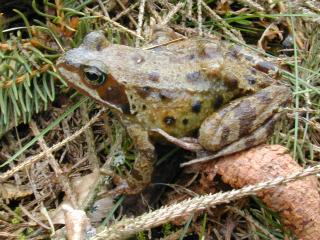
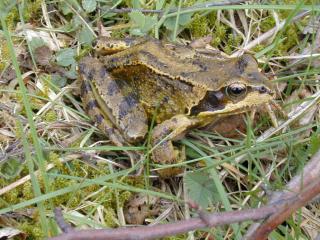
FROGS AND TOADS IN THE UK
Frogs and toads (anurans) are a well known group of amphibians. They have no tails as newts do, and their hind legs are elongated for jumping, and folded in a characteristic way when at rest. There is no scientific distinction between 'frogs' and 'toads'- 'toad' is generally used to describe a dry-skinned or warty animal, while 'frog' is reserved for those with smooth, moist skin, which are generally more fast-moving.
Three species of these tailless amphibians are regarded as native to the UK- the common frog, common toad, and natterjack toad. A fourth species, the pool frog, is also thought to be native, though this is not universally accepted.



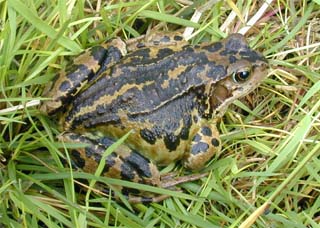
Common frog- four individuals, illustrating the variation in colouring. The fourth is an unusually dark specimen.
The common frog is the species most commonly encountered in the UK, and is often to be found in garden ponds. This species has a moist and smooth skin, which is usually a yellowish or brown colour. There is a dark 'mask' on each side of the head, behind the eyes. This frog moves by means of large hops or jumps. Common frogs reach a length of up to 8 cm total length.
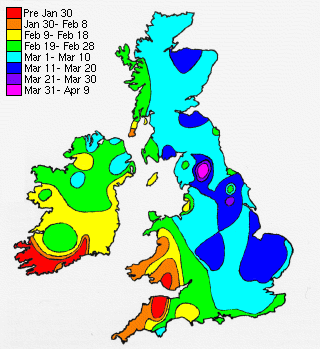
Date of common frog spawning (after Savage, 1961)
Common frogs breed in late winter or early spring. Temperature, sunlight and rainfall are among the factors which may influence the date of spawning. The map above shows typical spawn dates over the British Isles, based on observations in the 1930s.
At breeding time, a male frog will grab a female in an embrace known as amplexus. The pair will remain in this embrace for several hours. The male's grip is helped by his 'nuptial pads'- areas of rough skin on the 'thumbs' of the front legs. The pair produce a clump of frogspawn, which is a familiar sight in many ponds. Frogspawn consists of up to 2000 eggs, each consisting of a black embryo about 2mm in diameter, surrounded by a mass of protective jelly. This jelly swells on contact with the water, eventually becoming a sphere around 8mm in diameter. Tiny tadpoles develop from these embryos and will emerge within about two weeks, the exact time depending on temperature.
The tadpoles feed on plant and animal matter, using their rasping mouthparts, and grow rapidly. Within a few weeks, rear legs start to develop on their rounded bodies. At this time, common frog tadpoles have the characteristic tadpole appearance- a large round coppery or brown body, with a long wide tail. Front legs develop internally soon afterwards, and can be seen underneath their thin belly skin. After around three months, the front legs will break through the skin, and shortly afterwards, the long tail will begin to recede. The tadpole will then be able to leave the water, and metamorphosis into a tiny frog will be complete. The frog will then feed on tiny invertebrates, in a similar manner to the adults. Newly metamorphosed frogs are about 1 cm long.
Mortality is very high during the tadpole stage- the soft bodies of tadpoles make good food for a number of predators. Adult frogs are similarly vulnerable to predation by many species.
Frogs themselves are predators of a wide range of invertebrate species, including insects, spiders, worms, and slugs. They catch their prey by flicking out their sticky tongue, to which the prey item adheres, then pulling it back into their mouth. The tongue is attached at the front of the mouth, rather than the rear, enabling it to be flicked out over some distance.
The common frog is found in a wide variety of habitats over the whole of the UK, including Ireland, the Isle of Man, Anglesey, and the Isle of Wight, as well as some of the Scottish islands including the Shetland Islands, and Orkney. Very dry habitats are avoided, but almost any other habitat may used by common frogs outside the breeding season. Small ponds are particularly favoured for breeding, although larger waterbodies, and running water may be used.
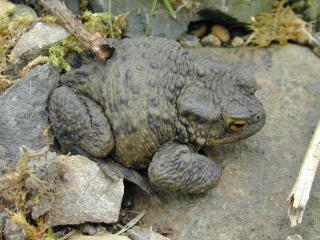
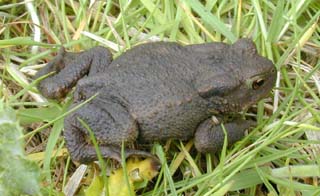
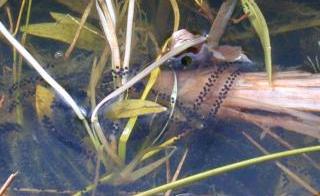

Adult and juvenile common toads, spawn, and tadpoles
The common toad is immediately distinguishable from the common frog by its dry warty skin, and its habit of walking rather than hopping. Common toads are usually some shade of brown, and are generally uniformly coloured, although they may have some black spotting. Their parotid glands can be seen as bulges behind the eyes. These glands, as well as their warts, produce a distasteful venom which provides some degree of protection against predators. It should be stressed that this presents no danger to man. Female common toads may reach a total length of 10 cm, males being rather smaller, and also less heavily built.
Common toads breed a few weeks later than common frogs in most parts of the UK, and produce somewhat different spawn. Toad spawn is a string of jelly with eggs embedded in it, usually wrapped around vegetation. Tadpoles emerge from this in a similar way to those of frogs, and develop in an identical manner. The tadpoles of common toads are a uniform black or very dark brown, and are slightly smaller than those of common frogs. Toad tadpoles appear to be distasteful to many predators, and, perhaps as a result of this, are much more often to be seen in open water than those of the common frog. 'Schools' containing many tadpoles are a common sight. Metamorphosis takes around three months, as in the common frog, and the young toads are about 1 cm in length on leaving the water.
This species occurs over a wide range of habitats throughout mainland Britain, the Isle of Wight, Anglesey, and some of the Scottish islands. It usually prefers somewhat drier conditions than the common frog. As it is nocturnal, it is most likely to be seen while turning rocks, logs or debris. Common toads prefer large waterbodies for spawning, and are much less likely to be seen in garden ponds, though more likely to spawn in running water.
NATTERJACK TOAD Bufo calamita (=Epidalea calamita)
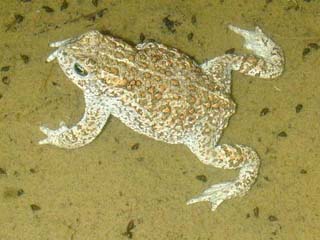
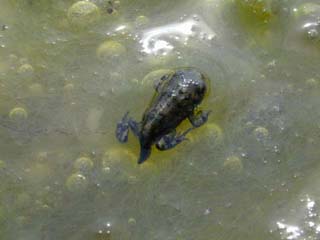
Adult natterjack, and a metamorphosing natterjack tadpole
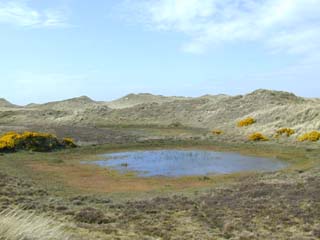
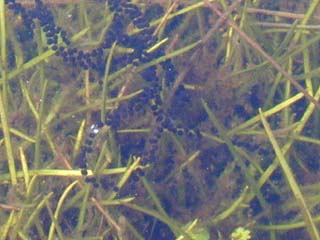
Natterjack habitat in Cumbria, and spawn from this site.
The natterjack toad is immediately recognisable by the yellow stripe along its back. It has a dry warty skin like that of the common toad. Natterjacks move in a different manner to the common toad- they have a mouse-like way of running, and shorter legs. Natterjacks are also generally smaller than the common toad, growing to around 7cm.
Natterjacks live and breed in different habitats to the common toad. The two main habitat types occupied in the UK are well-established coastal sand dunes, and heathland. The natterjack is a rare and endangered species and is legally protected. The ponds that natterjacks breed in tend to be temporary waterbodies, unlike the large permanent waterbodies favoured by common toads. Breeding takes place later in the year than for the common toad, commonly at some time between april and june. The spawn of natterjack toads is similar to that of the common toad, except that the spawn of the common toad contains two rows of eggs, whereas natterjack toad spawn has a single row. Development of the tadpoles is rapid, taking as little as six weeks. Natterjack toadlets are correspondingly small, being 7-10mm long.
On both heathland and dune sites, natterjacks live mainly in burrows that they excavate using their rear limbs. They are generally nocturnal, spending most of the day in their burrows.
Unlike common frogs and common toads, natterjacks have a loud and distinctive call. This is produced by the vocal sac of the male natterjack, which can be seen to be blown out under his chin during calling. The call has been described as a rasping "rrrrrrrrrRUP", higher pitched at the end.
Due to their specific habitat requirements, natterjack toads have a restricted distribution in the UK. They occur on coastal dunes in Norfolk, Suffolk, and Lincolnshire in eastern England, in Cumbria, Lancashire and Merseyside in north-west England, around the Solway Firth in south-west Scotland, and in County Kerry in south-west Ireland. The Irish populations are thought by some to result from human introduction. Heathland populations are known to occur in Hampshire, Norfolk, and Bedfordshire. Some of the colonies are the result of re-introduction to areas from which they have previously become extinct.
The pool frog is now thought to be a native species, though the issue has been clouded by many introductions of this and closely related species from continental Europe. Follow this link for more information on this species.
REFERENCES
Savage, R. M., 1961. The ecology and life history of the common frog. Pitman, London.